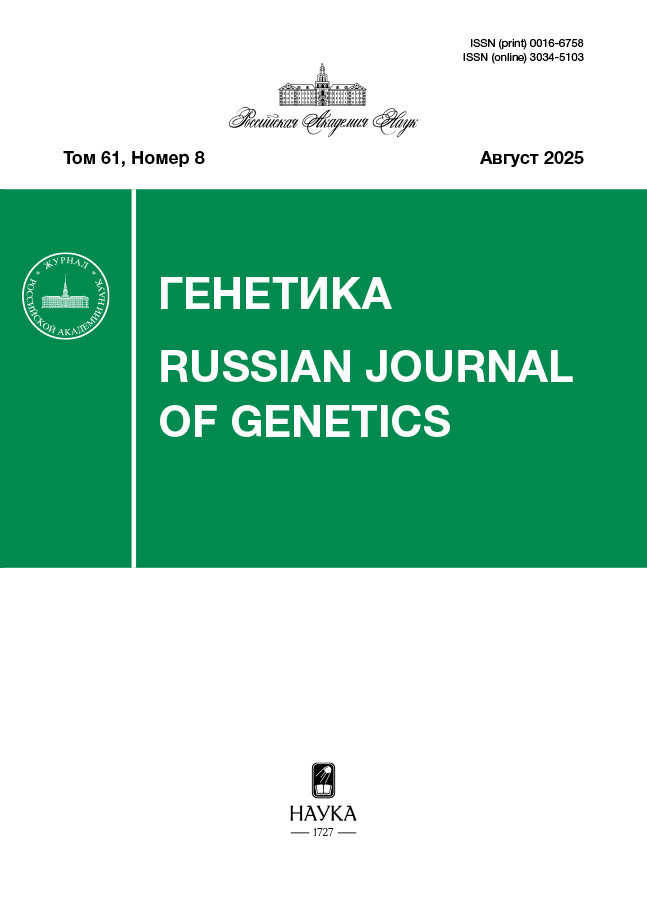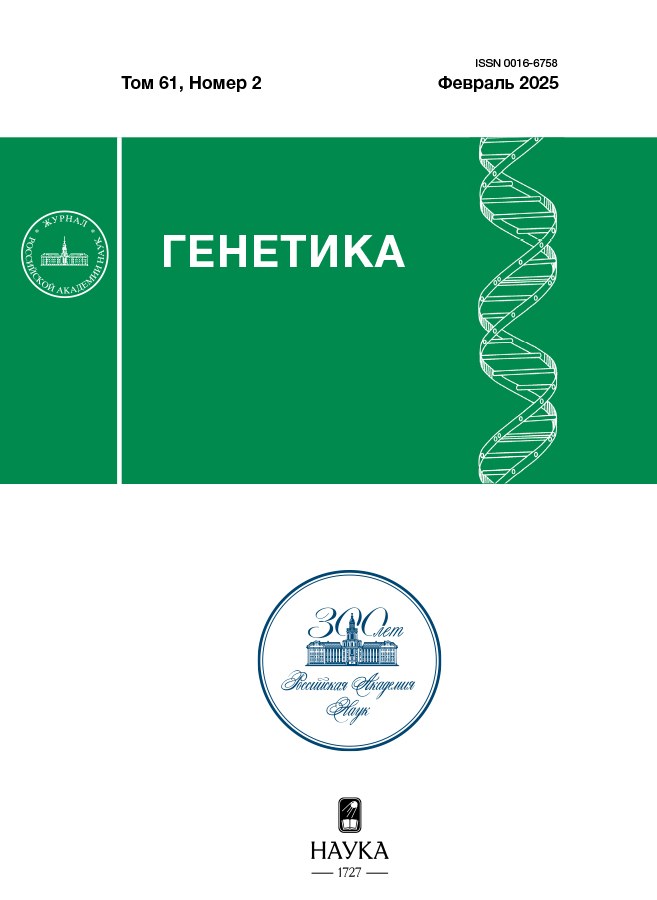Reparative Chromatin Assembly Plays an Important Role in Genome Stability
- Authors: Skobeleva I.I.1, Evstyukhina T.A.1,2, Alekseeva E.A.1,2, Toroshchina A.V.1, Peshekhonov V.T.1,2, Fedorov D.V.1, Korolev V.G.1,2
-
Affiliations:
- Petersburg Nuclear Physics Institute Named by B.P. Konstantinov of National Research Centre “Kurchatov Institute”
- Kurchatov Genome Center — Petersburg Nuclear Physics Institute
- Issue: Vol 61, No 2 (2025)
- Pages: 24-34
- Section: ГЕНЕТИКА МИКРООРГАНИЗМОВ
- URL: https://genescells.com/0016-6758/article/view/687007
- DOI: https://doi.org/10.31857/S0016675825020032
- EDN: https://elibrary.ru/uvvfzd
- ID: 687007
Cite item
Abstract
When DNA repair is completed, the processes associated with the restoration of the normal chromatin structure play an important role. Incorrect chromatin assembly can lead to genomic rearrangements, which, in turn, can cause the development of many diseases, including cancer. Previously, we showed that violations of the correct assembly of nucleosomes and their remodulation during the reparative assembly of chromatin lead to an increased level of mutagenesis. In this work, we have shown that the asf1Δ mutation has a constitutively hyperactivated Rad53 kinase, which causes disorganization of the chromatin structure and significantly changes the spectrum of spontaneous reparative mutations. Violation of the binding site of the Rad9 adaptive protein to DNA as a result of inactivation of the DOT1 gene eliminates hif1Δ-specific mutagenesis, which is a consequence of incorrect reparative assembly of nucleosomes. The absence of the Rad9 protein under normal growth conditions and when treated with low doses of UV rays leads to aberrant activation of the RNR complex. At the same time, a further increase in the dose of UV radiation practically does not affect the expression of RNR3. These results confirm that correct chromatin assembly is critical for the normal functioning of the genome.
Full Text
About the authors
I. I. Skobeleva
Petersburg Nuclear Physics Institute Named by B.P. Konstantinov of National Research Centre “Kurchatov Institute”
Author for correspondence.
Email: alekseeva_ea@pnpi.nrcki.ru
Russian Federation, Gatchina, 188300
T. A. Evstyukhina
Petersburg Nuclear Physics Institute Named by B.P. Konstantinov of National Research Centre “Kurchatov Institute”; Kurchatov Genome Center — Petersburg Nuclear Physics Institute
Email: alekseeva_ea@pnpi.nrcki.ru
Russian Federation, Gatchina, 188300; Gatchina, 188300
E. A. Alekseeva
Petersburg Nuclear Physics Institute Named by B.P. Konstantinov of National Research Centre “Kurchatov Institute”; Kurchatov Genome Center — Petersburg Nuclear Physics Institute
Email: alekseeva_ea@pnpi.nrcki.ru
Russian Federation, Gatchina, 188300; Gatchina, 188300
A. V. Toroshchina
Petersburg Nuclear Physics Institute Named by B.P. Konstantinov of National Research Centre “Kurchatov Institute”
Email: alekseeva_ea@pnpi.nrcki.ru
Russian Federation, Gatchina, 188300
V. T. Peshekhonov
Petersburg Nuclear Physics Institute Named by B.P. Konstantinov of National Research Centre “Kurchatov Institute”; Kurchatov Genome Center — Petersburg Nuclear Physics Institute
Email: alekseeva_ea@pnpi.nrcki.ru
Russian Federation, Gatchina, 188300; Gatchina, 188300
D. V. Fedorov
Petersburg Nuclear Physics Institute Named by B.P. Konstantinov of National Research Centre “Kurchatov Institute”
Email: alekseeva_ea@pnpi.nrcki.ru
Russian Federation, Gatchina, 188300
V. G. Korolev
Petersburg Nuclear Physics Institute Named by B.P. Konstantinov of National Research Centre “Kurchatov Institute”; Kurchatov Genome Center — Petersburg Nuclear Physics Institute
Email: alekseeva_ea@pnpi.nrcki.ru
Russian Federation, Gatchina, 188300; Gatchina, 188300
References
- Evstyukhina T.A., Alekseeva E.A., Fedorov D.V. et al. Genetic analysis of the Hsm3 protein function in yeast Saccharomyces cerevisiae NuB4 complex // Genes. 2021. V. 12. P. 1083. https://doi.org/10.3390/ genes12071083
- Alekseeva E.A., Evstyukhina T.A., Peshekhonov V.T. et al. The role of the RPD3 complex of Saccharomyces cerevisiae yeast in the activation of UV-induced expression of RNR complex genes // J. Biomed. Res. Environ. Sc. 2024. V. 5. P. 360–372. https://doi.org/10.37871/jbres1902
- Alekseeva E.A., Evstyukhina T.A., Peshekhonov V.T., Korolev V.G. Participation of the HIM1 gene of yeast Saccharomyces cerevisiae in the error-free branch of post-replicative repair and role Polη in him1-dependent mutagenesis // Curr Genet. 2021. V. 67. P. 141–151. https://doi.org/10.1007/s00294-020-01115-6
- Evstyukhina T.A., Alekseeva E.A., Peshekhonov V.T. et al. The role of chromatin assembly factors in induced mutagenesis at low levels of DNA damage // Genes. 2023. V. 14. P. 1242. https://doi.org/10.3390/genes14061242
- Евстюхина Т.А., Алексеева Е.А., Скобелева И.И. и др. Роль различных субъединиц ремоделирующего комплекса INO80 в репарационной сборке хроматина у дрожжей Saccharomyces cerevisiae // Генетика. 2024. Т. 60. № 7. P. 000.
- Weinert T.A., Hartwell L.H. The RAD9 gene controls the cycle response to DNA damage checkpoint in Saccharomyces cerevisiae // Science. 1988. V. 241. P. 317–322. https://doi.org/10.1126/science.3291120
- Vialarg J.E., Gilbert C.S., Green C.M., Lowndes N.F. The budding yeast Rad9 checkpoint protein is subjected to Mec1/Tel1-dependent hyperphosphorylation and interacts with Rad53 after DNA damage // EMBO J. 1998. V. 17. P. 5679–5688. https://doi.org/10.1093/emboj/17.19.5679
- Granata M., Lazzaro F., Novarina D. et al. Dynamics of Rad9 chromatin binding and checkpoint function are mediated by its demirization and are cell cycle-regulated by CDK1 activity // PLoS Genetics. 2010. V. 6. P. e1001047. doi:10.1371/ journal.gen.1001047
- Sun Z., Hsiao J., Fay D.S., Stern D.F. Rad53 FHA domain associated with phosphorylated Rad9 in the DNA damage checkpoint // Science. 1998. V. 281. P. 272–274. https://doi.org/10.1126/science.281.5374.272
- Wysocki R., Javaheri A., Allard S. et al. Role of Dot1-dependent histone 3 methylation in G, and S phase DNA damage checkpoint functions of Rad9 // Mol. Cell. Biol. 2005. V. 25. P. 8430–8443. https://doi.org/10.1128/MCB.25.19.8430-8443.2005
- Javaheri A., Wisocki R., Jobin-Robitaille O. et al. Yeast G1 DNA damage checkpoint regulation by H2A phosphorylation is independent of chromatin remodeling // PNAS. 2006. V. 12. P. 13771–13776. doi/10.1073/pnas.0511192103
- Захаров И.А., Кожин С.А., Кожина Т.А. и др. Сборник методик по генетике дрожжей-сахаромицетов, изд. 2-е. Л.: Наука, 1984. 144 с.
- Keck K.M., Pemberton L.F. Histone chaperon link histone nuclear import and chromatin assembly // Biochim. Biophys. Acta. 2012. V. 1819. P. 277–289. https://doi.org/10.1016/j.bbagrm.2011.09.007
- Adkins M.W., Williams S.K., Linger J., Tyler J.K. Chromatin disassembly from the PHO5 promoter is essential for the recruitment of the general transcription machinery and coactivators // Mol. Cell. Biol. 2007. V. 27. P. 6372–6382. https://doi.org/10.1128/MCB.00981-07
- Mousson F., Ochsenbein F., Mann C. The histone chaperone Asf1 at the crossroads of chromatin and DNA checkpoint pathways // Chromosoma. 2007. V. 116. P. 79–93. https://doi.org/10.1007/s00412-006-0087-z
- Tyler J.K., Adams C.R., Chen S.R. et al. The RCAF complex mediates chromatin assembly during DNA replication and repair // Nature. 1999. V. 402. P. 555–560. https://doi.org/10.1038/990147
- Prado F., Cortes-Ledesma F., Aguilera A. The absence of the yeast chromatin assembly factor Asf1 increases genomic instability and sister chromatid exchange // EMBO Rep. 2004. V. 5. P. 497–502. https://doi.org/10.1038/sj.embor.7400128
- Myung K., Pennaneach V., Kats E.S., Kolodner R.D. Saccharomyces cerevisiae chromatin-assembly factors that act during DNA replication function in the maintenance of genome stability // Proc. Natl Acad. Sci. USA. 2003. V. 100. P. 6640–6645. https://doi.org/10.1073/pnas.1232239100
- Kozmin S.G., Pavlov Y.I., Kunkel T.A., Sage E. Roles of Saccharomyces cerevisiae DNA polymerases Polη and Polζ in response to irradiation by simulated sunlight // Nucl. Acids Res. 2003. V. 31. P. 4541–4552. https://doi.org/10.1093/nar/gkg489
- Кожина Т.Н., Евстюхина Т.А., Пешехонов В.Т. и др. Гистон-метилазы Dot1 и Set2 контролируют уровень спонтанного и УФ-индуцированного мутагенеза в дрожжах Saccharomyces cerevisiae // Генетика. 2016. Т. 52. № 3. С. 300–310.
- Sharp J.A., Fouts E.T., Krawitz D.C., Kaufman P.D. Yeast histone deposition protein Asf1p requires Hir proteins and PCNA for heterochromatic silencing // Curr Biol. 2001. V. 11. P. 463–473. https://doi.org/10.1016/s0960-9822(01)00140-3
- Ge Z., Wang H., Parthun M.R. Nuclear Hat1p complex (NuB4) components participate in DNA repair-linked chromatin reassembly // J. Biol. Chem. 2011. V. 286. P. 16790–16799. https://doi.org/10.1074/jbc.M110.216846
- Bostelman L.J., Keller A.M., Albrecht A.M. et al. Methylation of histone H3 lysine-79 by Dot1p plays multiple roles in the response to UV damage in Saccharomyces cerevisiae // DNA Repair. 2007. V. 6. P. 383–395. https://doi.org/10.1016/j.dnarep.2006.12.010
- Conde F., San-Segundo P.A. Role of Dot1 in the response to alkylating DNA damage in Saccharomyces cerevisiae: Regulation of DNA damage tolerance by the error-prone polymerases Polzeta/Rev1 // Genetics. 2008. V. 179. P. 1197–1210. https://doi.org/10.1534/genetics.108.089003
Supplementary files


















